
Fractures Page Menu: 1 2 3 4 5 6 7 8 9 10 11 12 Next>>
Fracture Treatment During the Golden Age of Piracy, Page 1
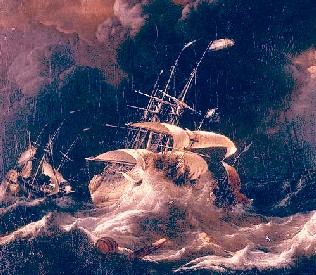
Artist: Lludolf Bakhuisen
Dutch Merchant Ships in a Storm (late 17th century)
"The sea was swelled into billows mountain high, on the top of which, our ship sometimes hung as if it was about to be precipitated to the abyss below Sometimes we sunk between two waves that rose on each side higher than our top-mast head, and threatened, by dashing together, to overwhelm us in a moment! ... While I considered this scene with equal terror and astonishment, one of the main braces broke, by the shock whereof two sailors were flung from the yard's arm into the sea, where they perished, and poor Jack Rattlin was thrown down upon the deck, at the expense of a broken leg. Morgan and I ran immediately to his assistance, and found a splinter of the shin-bone thrust by the violence of the fall through the skin. As this was a case of too great consequence to be treated without the authority of the doctor, I went down to his cabin to inform him of the accident, as well as to bring up dressings, which we always kept ready prepared." (Tobias Smollett, The Adventures of Roderick Random, p. 183-4)
Although Smollett was writing a fictional account based on his tenure as a surgeon's mate at sea, he was clearly speaking from experience. Broken bones were a constant threat to seamen. The men were called upon in all conditions to climb up into the masts and down into the holds and to move bone-crushingly heavy cargo and cannons about the decks. There were many chances for a sailor to fracture a bone.
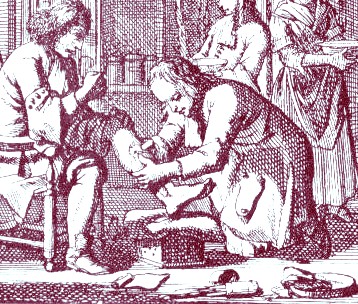
Artist: Jan Luyken
Surgeon Examining a Leg, From Het Menselyk (1694)
When a man's bone fractured, the surgeon, his assistants and mates would be called upon to repair the break and get the man back into active duty as soon as they were able. Treatment depended on the type of fracture - simple or compound. The basic theory behind repairing bone fractures was fairly well understood by this time and is similar in many ways to what is done today. The surgeon would begin by determining if the bone was broken, ready his equipment and then restore the bone back to its proper place. The surgeon's most important involvement in the process was setting the bone, so many aspects of this process were discussed in detail in period surgical manuals.
Once the bone was set, the repaired part was bandaged to render it immobile. This was to allow the formation of a callus so that the bone could heal the fracture itself. Several post-operative procedures were considered by period surgeons including making sure healing was facilitated through wound treatment, diet and medicines. Other post-operative complications were addressed including pain, swelling, itching and preventing gangrene. The article will look at each of these and finish with a case study reminiscent of Smollett's account involving a commander who fell from the mizzen top mast, "breaking his Leg transverse near the Ancle, the edge of the Bone thrusting out through the Skin."1
1 Richard Wiseman, Of Wounds, Severall Chirurgicall Treatises, p. 475
Fractures at Sea
There were many ways for men to fracture bones at sea and several examples are found in period accounts. When considering such wounds, the first thing that jumps to many people's minds is fractures occurring in battle. Sea surgeon John
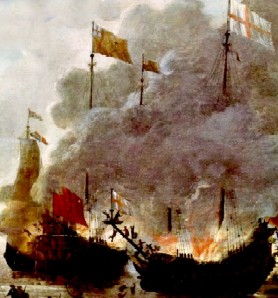
Artist: Jan van Leyden
The Battle in the Medway (1667)
Moyle advised his readers, "if you go into the Wars, you must expect wounds and broken Bones, then you must carry more quantity of Vulneraries [medicines used to heal wounds], than if you were not bound into the Wars."1
Broken bones could occur in many ways during battle. Few were created by direct hits with cannon fire; in fact, all of the accounts I have found of cannon-related fracture wounds are indirect, rather than direct, results of ordnance hits.
For example, naval surgeon John Atkin's explained how a sailor "received a Compound Fracture of his Right leg, by a Splinter in an Engagement with the Enemy"2. This fracture was not created by the direct impact of an enemy projectile, but from a large splinter of wood, most likely created by cannon shot crashing into the wood structure of the ship. The sliver left behind it a piece of bone "larger than the rest, which not being separated from the Membranes, I replaced, and found afterwards [it was able] to unite with the Whole."3
Military surgeon Richard Wiseman detailed how during a "Fight at Sea, amongst the many wounded men that were put
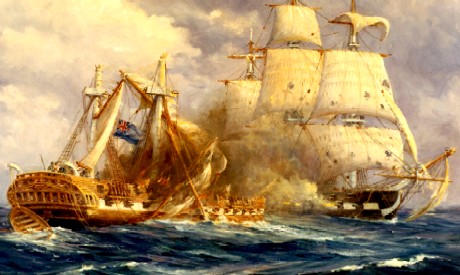
Artist: Anton Otto Fischer
USS Constitution v HMS Guerriere
down into the Hold to [be treated by] me, one of them had his right Arm extreamly shattered about two Fingers breadth, on the outside above the Elbow, by a great Splinter."4
Splinters, being far more numerous and spraying in a wide pattern, were a much greater fracture threat than direct hits from artillery.
Wiseman wanted to amputate the man's arm, but was distracted when the ship caught fire. "I hastily clapt a Dressing upon the Wound, and rouled it up, leaving his Arm in his other Hand to support it, and endeavoured to get up out of the Hold as the others did, verily believing I should never dress him nor any of them more."5 Fortunately for all involved, the fire was put out, although Wiseman was now tasked with repairing the man's arm rather than the more rapid removal.
In another battle example, sea surgeon John Yonge (then a young man bound to the surgeon of the ship Constant Warwick in 1658) reported that during an engagement with another, unnamed ship, "Venice Hide [had] his leg broken by the overturning of a great gun."6
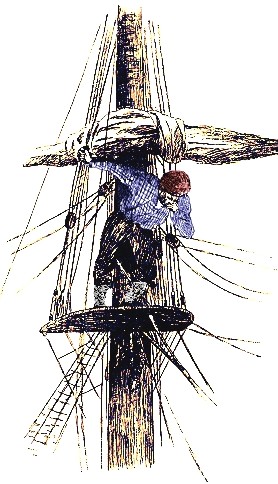
Artist: Frederick Ehrlich
From Pirates and Piracy, by Oscar Herrmann (1902)
Not all such fractures were battle-related. Sea surgeon Hugh Ryder discusses a man aboard the Royal James who "fell down from the Foreyard upon a piece of Ordnance on the Forecastle... [resulting in] a Fracture of the left Clavicle, Dislocation of the Shoulder, and a compound Fracture of the Leg... the bones of the Leg coming through his stockins."7 Privateer George Shelvocke noted that after leaving St. Catherine's in Brazil, "Mr. La Port, my third Lieutenant, broke his leg by a slide on the deck."8
Falling while working in the sails seems to have been a common cause of fractured bones. Moyle considers a "Man being up aloft, knotting the Rigging, and having the Rope under his Feet shot away, he falls down upon the Deck, breaks the bone of his Leg"9. When pirate Edward Low captured the brigantine Rebecca in 1722, they forced sailor Robert Willis to join the pirate crew, despite the "said Willis having broke his Arm by a Fall from the Mast"10.
Any number of things could happen on a ship resulting in a fracture. John Atkins tells of "a Young Man of twenty Years of Age fractured his Thigh, by a Surging of the Cable, about four Fingers Breadth above the Knee."11
Other types of fractures occurred as well. In June of 1710, privateer commander Woodes Rogers had a piece of shot in his jaw removed "which had been there near 8 Months, ever since I was first wounded; we reckon'd it a Piece of my Jaw-bone, the upper and lower Jaw being much broken, and almost closed together, so that the Doctor had much ado to come at the Shot to get it out. I had also several Pieces of my Foot and Heel-bone taken out, but God be thanked, am now in a fair way to have the Use of my Foot and recover my Health."12
Military
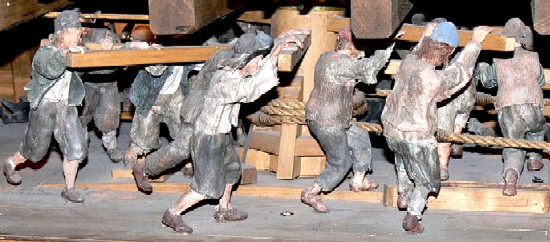
Artist: Wolfgang Sauber -
Men Working a Capstan from the Vasa Museum Mode
surgeon William Clowes reveals how an accident occurred while serving as ship's surgeon on the Aide. "[B]y reason of the storm and tempest, and by some negligence and oversight, upon a sudden the Capstan turned about with great force and violence, and did bruise and hurt divers [many], specially the boatswain's servant whose name was called Ralph Condall, who had two of his ribs fractured and broken by the force of the said blow of the Capstan bar"13.
Even the medical personnel were not immune to broken bones. In explaining how a fire started aboard the ship he was serving on, sea surgeon James Yonge revealed that the "chyrurgeon’s son, who lay with a broken leg in my cabin, being almost chokd with a the smoke, made shift to crawl up and cry Fire"14. It was a good thing the surgeon's son was recuperating; Yonge suggests the ship would have gone up in flames had the alarm not been given. Then they'd be dealing with multiple burns instead of a fractured leg.
1 John Moyle, Abstractum Chirurgæ Marinæ, p. 6; 2,3 John Atkins, The Navy Surgeon, p. 69; 4,5 Richard Wiseman, Of Wounds, Severall Chirurgicall Treatises, p. 425; 6 James Yonge, The Journal of James Yonge [1647-1721] Plymouth Surgeon, p. 30; 7 Hugh Ryder, New Practical Observations in Surgery, p. 10-1; 8 George Shelvocke, A Voyage Round the World by Way of the Great South Sea, 1726, p. 58; 9 John Moyle, The Sea Chirurgeon, p. 115; 10 New England Courant, 5-20-23 - 5-27, Issue 95; 11 Atkins, p. 59;12 Woodes Rogers, A Cruising Voyage Round the World, p. 204-5; 13 William Clowes, Selected Writings of William Clowes, p. 95-6; 14 James Yonge, The Journal of James Yonge [1647-1721] Plymouth Surgeon, p. 50

